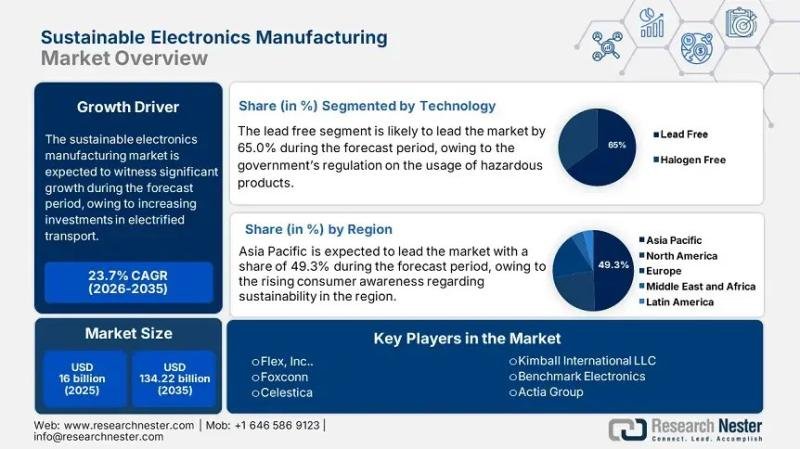The sustainable electronics manufacturing market is gaining global traction as environmental sustainability becomes a strategic imperative across industries. Valued at USD 16 billion in 2025, the market is projected to reach an impressive USD 134.22 billion by 2035, reflecting a robust 23.7% growth rate between 2026 and 2035. Driven by rising environmental regulations, circular economy initiatives, and growing consumer awareness of e-waste issues, the market is witnessing rapid adoption of eco-friendly production methods, renewable energy integration, and responsible sourcing of raw materials.
Sustainable electronics manufacturing focuses on reducing the environmental footprint throughout the product lifecycle – from material selection and energy-efficient production to waste management and recycling. Manufacturers are shifting toward lead-free solders, biodegradable materials, and energy-optimized facilities to meet regulatory standards and achieve carbon-neutral operations. Governments worldwide are enforcing stricter compliance frameworks such as the EU’s Restriction of Hazardous Substances (RoHS) directive and Waste Electrical and Electronic Equipment (WEEE) regulations, pushing the electronics sector toward greener manufacturing practices.
The transition to sustainable production is also driven by technological innovation. Automation, digital twins, and artificial intelligence are enabling smarter, leaner manufacturing processes that minimize material wastage and optimize energy use. Major electronics producers are investing in closed-loop recycling systems and environmentally friendly packaging to align with sustainability goals and consumer expectations.
➤ Request Free Sample PDF Report @ https://www.researchnester.com/sample-request-7411
Regional Performance Highlights
The Sustainable Electronics Manufacturing Market displays diverse regional growth dynamics influenced by policy frameworks, industrial maturity, and investment in green technologies.
The North America region is poised for significant expansion during the forecast period, fueled by strong government policies promoting clean manufacturing and corporate sustainability initiatives. The U.S. is at the forefront, with technology giants integrating renewable energy sources, circular economy principles, and carbon-neutral targets into their operations. The growing emphasis on domestic semiconductor production, coupled with environmental compliance mandates, is further propelling the shift toward sustainable practices.
Europe remains a global leader in sustainability-driven innovation, backed by stringent regulatory standards and active participation in the circular economy. The European Green Deal and initiatives such as the Right to Repair Directive are encouraging manufacturers to adopt recyclable components and longer product life cycles. Nations like Germany, Sweden, and the Netherlands are pioneering sustainable electronics R&D hubs, where companies are developing eco-efficient production methods and energy-optimized semiconductor fabrication facilities.
Accounting for nearly 49.3% of revenue share by 2035, Asia Pacific dominates the global landscape. The region’s leadership is supported by large-scale manufacturing bases in China, Japan, South Korea, and India. Increasing government efforts to curb carbon emissions, combined with major investments in renewable energy infrastructure, are promoting green factory transformation. Moreover, the rise of contract manufacturers and Electronic Manufacturing Services (EMS) providers adopting environmentally conscious processes underscores the region’s commitment to sustainable production.
➤ Gain access to expanded insights on competitive strategies, market size, and regional analysis. View our Sustainable Electronics Manufacturing Market Report Overview here: https://www.researchnester.com/reports/sustainable-electronics-manufacturing-market/7411
Segmental Insights
The Sustainable Electronics Manufacturing Market is segmented based on material type, production process, and application area, reflecting the industry’s multi-dimensional evolution toward sustainability.
The lead-free segment dominates the market, holding approximately 65% of revenue share by 2035. Lead-free soldering has become the industry norm as manufacturers replace toxic lead-based materials with alternatives such as tin-silver-copper alloys. This transition aligns with global environmental safety directives and consumer demand for greener electronics. Lead-free materials also improve recyclability and reduce health hazards associated with electronic waste processing.
The Electronic Manufacturing Services (EMS) segment is witnessing steady growth as OEMs increasingly outsource production to specialized partners with advanced sustainability capabilities. EMS providers are implementing low-carbon manufacturing technologies, renewable energy-powered facilities, and responsible sourcing practices to meet ESG targets. These collaborations are driving systemic sustainability improvements across the entire electronics value chain.
Sustainable electronics manufacturing practices are now embedded across consumer electronics, automotive, healthcare, and industrial equipment sectors. For instance, the shift toward electric vehicles and renewable energy systems is accelerating demand for eco-friendly semiconductor components, sensors, and power management systems.
➤ Discover how the Sustainable Electronics Manufacturing Market is evolving globally – access your free sample report → https://www.researchnester.com/sample-request-7411
Top Market Trends
The transformation of the Sustainable Electronics Manufacturing Market is being driven by key trends that redefine how devices are designed, produced, and recycled. The integration of digital technologies, eco-materials, and energy efficiency is setting new standards for sustainable innovation.
1. Circular Economy and E-Waste Recycling
The shift toward a circular economy is reshaping electronics manufacturing. Companies are focusing on extending product lifecycles through repairability, refurbishment, and component recovery. Major electronics manufacturers are launching take-back programs and recycling initiatives to reclaim valuable materials from discarded devices. For example, Apple’s Daisy robot disassembles old iPhones to recover rare earth metals, while Dell and HP are producing new products using recycled plastics and metals. This trend is reducing landfill waste and minimizing reliance on virgin resources.
2. Integration of Renewable Energy in Manufacturing
The use of renewable energy sources such as solar, wind, and hydropower is becoming a central pillar of sustainable electronics production. Leading companies are committing to 100% renewable energy goals for their factories and data centers. Renewable-powered fabrication plants not only lower carbon emissions but also enhance long-term cost efficiency. Semiconductor giants like TSMC and Samsung are investing heavily in renewable-powered facilities to achieve carbon neutrality by the early 2030s.
3. Digitalization and Smart Factory Adoption
Digital transformation is enabling smart manufacturing ecosystems where AI, IoT, and robotics optimize production efficiency while reducing waste and energy consumption. Digital twins allow manufacturers to simulate entire production processes, ensuring minimal material wastage and efficient resource allocation. Additionally, data analytics is improving predictive maintenance, reducing equipment downtime, and enhancing overall energy management. Companies adopting Industry 4.0 technologies are achieving a dual benefit – sustainability and productivity.
➤ Stay ahead of the curve with the latest Sustainable Electronics Manufacturing Market trends. Claim your sample report → https://www.researchnester.com/sample-request-7411
Recent Company Developments
Several leading manufacturers and technology providers are spearheading initiatives that combine innovation with environmental responsibility. The following companies have made notable contributions to advancing sustainability within the electronics manufacturing ecosystem.
1. Apple Inc. – Expanded its recycling capabilities with the launch of new material recovery robots and increased the use of 100% recycled aluminum and gold in device components. The company also announced a commitment to achieving complete carbon neutrality across its supply chain by 2030.
2. Samsung Electronics Co., Ltd. – Introduced energy-efficient semiconductor fabrication techniques and pledged to transition to renewable energy in all global operations by 2027. The company also launched eco-packaging solutions for its consumer electronics portfolio.
3. Intel Corporation – Announced a multi-billion-dollar investment in green semiconductor manufacturing facilities aimed at minimizing water consumption and achieving net-zero greenhouse gas emissions in its global operations by 2040.
4. Sony Group Corporation – Strengthened its “Road to Zero” environmental plan by integrating recyclable materials into product design and reducing packaging waste. Sony’s manufacturing plants are now increasingly powered by renewable energy.
5. Foxconn Technology Group – Invested in sustainable factory infrastructure with solar-powered manufacturing lines and AI-based production monitoring systems that reduce material waste and energy usage.
➤ Request Free Sample PDF Report @ https://www.researchnester.com/sample-request-7411
Related News –
https://www.linkedin.com/pulse/can-asset-performance-management-revolutionize-jxwkf/
https://www.linkedin.com/pulse/what-future-fraud-management-banking-market-labdc/
Contact Data
AJ Daniel
Corporate Sales, USA
Research Nester
77 Water Street 8th Floor, New York, 10005
Email: info@researchnester.com
USA Phone: +1 646 586 9123
Europe Phone: +44 203 608 5919
About Research Nester
Research Nester is a one-stop service provider with a client base in more than 50 countries, leading in strategic market research and consulting with an unbiased and unparalleled approach towards helping global industrial players, conglomerates and executives for their future investment while avoiding forthcoming uncertainties. With an out-of-the-box mindset to produce statistical and analytical market research reports, we provide strategic consulting so that our clients can make wise business decisions with clarity while strategizing and planning for their forthcoming needs and succeed in achieving their future endeavors. We believe every business can expand to its new horizon, provided a right guidance at a right time is available through strategic minds.
This release was published on openPR.













